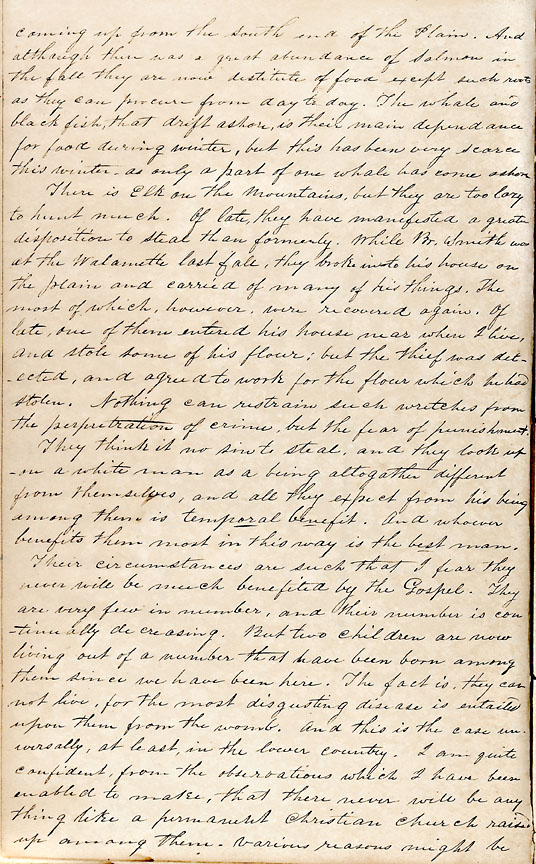The document above is an excerpt from the journal of Methodist missionary Joseph H. Frost (1805-1864). Written in the winter of 1841-1842, it describes missionary life near present-day Astoria.
Frost and his family were part of the “Great Reinforcement,” a group of several dozen Methodist missionaries who arrived in Oregon in May 1840. Together with fellow missionary William Kone, Frost was assigned to set up a mission among the Chinook and Clatsop Indians at the mouth of the Columbia River.
The missionaries’ relationship with the local Indians was cordial at first. A group of Clatsops under headman Kotata helped the Frosts build their first house, and the missionaries often hired Indian canoes to ferry them to and from the Willamette Valley, where the main Methodist Mission was located. Although the Clatsops expressed some interest in Frost’s discussions of religion, they were more interested in how the missionaries could help them economically. Just a few years prior to the Frosts’ arrival an outbreak of malaria had swept through the lower Columbia River region, decimating Indian populations and severely disrupting their economy.
Frost, however, was unable to do much to aid his Clatsop neighbors. Although he occasionally visited local Indian villages, he spent most of his time trying to provide for his own family, often spending weeks away from home obtaining supplies from Fort Vancouver and the Willamette Valley. He made little progress in promoting Christianity to the local Indians, and in his journal there are no references to having made any converts in the three years he spent in what he calls “this lonely, [sic] and dreary region.”
By the winter of 1841-1842, the frustration and isolation of missionary life was clearly weighing heavily on Frost’s mind. The Methodist Church provided minimal financial support, and to make matters worse, health problems plagued both Frost and his wife. His wife experienced recurring bouts of what was probably malaria, while he had throat problems that limited his ability to preach to the Indians. In the entry for February 2, 1842, reproduced above, Frost laments that “there will never be any thing like a permanent Christian church raised up among them….[I]t is exceedingly painful to reflect that we have laboured and toiled in vain.” Frost and his family left Oregon in August 1843, returning to New York, where Frost worked as a minister.
Further Reading:
Lowenberg, Robert J. Equality on the Oregon Frontier: Jason Lee and the Methodist Mission, 1834-1843. Seattle: 1976.
Pipes, Nellie B. “Journal of John H. Frost, 1840-43.” Oregon Historical Quarterly 35, 1934: 50-73, 139-167, 235-262, 348-375.
Written by Cain Allen, © Oregon Historical Society, 2006.
